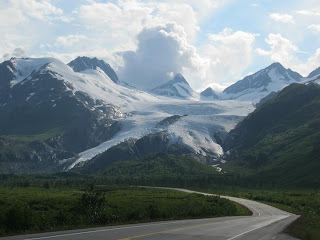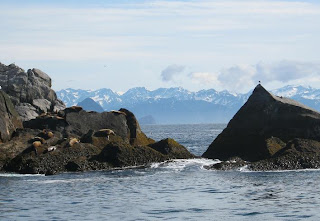This is page 31 of our Alaska 2011
trip journal. Click
here for the first page. If you want to bookmark this journal,
http://jeanne-travels.blogspot.com always links to the newest page.
If you are watching the dates on these posts, you will notice a couple days here out of sequence. Sometimes I like to cover things in a logical sequence, rather than jumping around from place to place and back.
The Harding Icefield and the glaciers flowing from it cover over 700 square miles, making it one of the the largest icefields in North America. They are not sure how deep it is, but they do know it is over 1,000 feet in some places. Kenai Fjords National Park encompasses part of this area.
View Larger Map
This map shows a satellite view of the area. The large, white area is the Harding Icefield. The grayish stripes coming between the mountain tops are the glaciers spawned from the icefield.
Exit Glacier
Exit Glacier is northwest of Seward, along the eastern of the icefield. It is the only place where you can get into the national park by road. Other than that, it is only accessible by sea or air. They called this one Exit Glacier, because it was the most convenient place for expeditions to exit the icefield.
The first view of the glacier is along the road into the park. The glacial stream at this point was also quite high, although I'm quite sure it is a wide braided river somewhere behind the brush. It just happened to braid itself along the road at this point. In other words, it has a lot of room to spread before it encroaches on the road.

From the visitor center you can take a short hike to a closer view of the glacier, or a much longer hike up to the icefield. I probably would have enjoyed seeing the icefield, but the distance and elevation change would have been a lot more than I could have handled. We did take the shorter hike, though. We were also able to walk out onto the outwash plain, but not all the way to the glacier.

And what would a walk in the woods be without more wildflowers? Seems every place we go, we see something else that we have not seen before. First is Pink Pyrola, also known as Arctic Wintergreen, the other two pictures are Columbine.

We first saw Cow Parsnips around Trapper Creek. They are huge, looking like Queen Anne's Lace on steroids, but prickly and feeling like stinging nettles. In some areas they dominate the roadside, to the exclusion of other plants. I'm not sure if they are a wildflower, or more like a weed.

This isn't a wildflower, but still it was interesting. Notice how most of the leaves are missing from the bushes here. These are willows, a favorite treat for moose. We also saw mooseberries (i.e. scat) along the path, so it was pretty clear there had been moose in the area fairly recently, making the path into a bit of a smorgasbord. But they probably make themselves scarce during the daytime when there are a lot of people around. At any rate, we didn't see any while we were here.
Kenai Fjords Glacier Cruise
We took a tour boat to see some of the glaciers from the water, and hoping to see some calving as well. The tour focused more on the sea life than the glaciers, so I was a little disappointed about that. But we did see sea life, and a calving glacier, and beautiful scenery, so it was still a good trip.
Humpbacks
Of course we saw humpback whales, but the pictures we got were not as good as the last trip. We also saw orca later in the trip, but were not able to get pictures.
Sea Lions

We saw sea lions surrounded by beautiful scenery, but no harbor seals on this trip...
Puffins
Puffins are strange birds, looking kind of like a cross between a penguin and a duck. They stand like a penguin, and swim like a duck. These are the only puffins we have seen, so I am including the pictures even though they are really fuzzy and bad.

There were also three cormorants on a nearby ledge. You can't see them very well in the picture because it's so fuzzy.
Bear Glacier

It's hard to tell from the picture, but Bear Glacier is land-locked, so we did not cruise up to it. So far, it is one of the largest glaciers we have seen, even though it was only at a distance.
More Scenery
These pictures were taken as we sailed around the point into Aialik Bay to see Holgate Glacier.
Holgate Glacier

A glacier that ends in the sea is called a tidewater glacier. When ice chunks fall from a tidewater glacier, it is called calving. The calving causes the glacier to pretty much end in a huge wall of ice. Holgate is our first view of a tidewater glacier. The first picture was actually taken as we left the area, but it's the best view of the entire glacier. When you get closer to the ice wall, you can't see the top as well.
The next two pictures show the ice wall - the second is a closer view near the top. As the glacier moves downhill, it splits and breaks, creating sometimes deep and treacherous crevasses. You can actually hear the breaking, echoing across the crevasses, and sounding almost like rifle shots. You can see some of the splits here, but I think you have to be on top to atually see much of the crevasses.
The next picture shows a little waterfall squirting out from under the glacier. Of course that is not the only water coming from the glacier, but most of it is not visible.
The pile of ice in the next picture is fallen ice from the calving.
Nearby Views

There was another glacier also coming down to the Holgate Arm, though it was landlocked. Here is a picture of it, and a couple other spots on the crest of the Holgate Arm.
Icebergs
The glacial ice crackles and pops like rice krispies as it melts in the water. This is caused by air that was trapped as the ice crystals formed. I took some pictures of the icebergs, including one with a sea lion basking on top.
 We stopped at the visitor center downtown, where we met this sleepy-looking bear. A drive around the harbor yielded a view of the city skyline. The last view is from Earthquake Park, which commemorated the 1964 earthquake. The bluff we were standing on is above where the ground sunk during the quake. That spot will probably go down in the next quake. The clay underneath is of a type that basically turns to jelly when it shakes. This is only a matter of time, since this part of Alaska is on the Pacific Ring of Fire.
We stopped at the visitor center downtown, where we met this sleepy-looking bear. A drive around the harbor yielded a view of the city skyline. The last view is from Earthquake Park, which commemorated the 1964 earthquake. The bluff we were standing on is above where the ground sunk during the quake. That spot will probably go down in the next quake. The clay underneath is of a type that basically turns to jelly when it shakes. This is only a matter of time, since this part of Alaska is on the Pacific Ring of Fire.



















































































